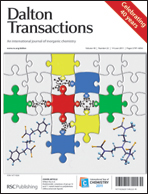Two structurally different Er-formate frameworks, one NaCl-like [dmenH2][Er(HCOO)4]2 (1) and the other pillared-layer type [tmenH2][Er(HCOO)4]2 (2), were obtained when templated by the corresponding protonated N,N′-dimethylethylenediamine (dmenH2) and N,N,N′,N′-tetramethyl- ethylenediamine (tmenH2). The shape and size of the template cations dictate the different coordination geometries of erbium and consequently the framework topologies, though erbium adopts eight coordination in the two compounds. In the NaCl-like structure of 1, erbium is coordinated by eight anti-anti bridging formates in a square antiprism, while in the pillared-layer structure of 2, it is coordinated by six anti-anti bridging formates and one chelating formate in a pentagonal bipyramid. 2 exhibits a structural phase transition around −70 °C which is related to the disorder–order transition of the template cation. Both compounds behave as paramagnets between 2 and 300 K. However, they display field-dependent ac-susceptibilities with complicated field-induced magnetic relaxation processes, and the major slow ones probably results from spin–lattice relaxation.

You have access to this article
 Please wait while we load your content...
Something went wrong. Try again?
Please wait while we load your content...
Something went wrong. Try again?


 Please wait while we load your content...
Please wait while we load your content...